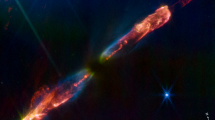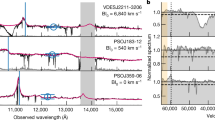Abstract
The birth of stars involves not only accretion but also, counter-intuitively, the expulsion of matter in the form of highly supersonic outflows1,2. Although this phenomenon has been seen in young stars, a fundamental question is whether it also occurs among newborn brown dwarfs: these are the so-called ‘failed stars’, with masses between stars and planets, that never manage to reach temperatures high enough for normal hydrogen fusion to occur3. Recently, evidence for accretion in young brown dwarfs has mounted4,5,6, and their spectra show lines that are suggestive of outflows7,8,9. Here we report spectro-astrometric data that spatially resolve an outflow from a brown dwarf. The outflow's characteristics appear similar to, but on a smaller scale than, outflows from normal young stars. This result suggests that the outflow mechanism is universal, and perhaps relevant even to the formation of planets.
This is a preview of subscription content, access via your institution
Access options
Subscribe to this journal
Receive 51 print issues and online access
$199.00 per year
only $3.90 per issue
Buy this article
- Purchase on Springer Link
- Instant access to full article PDF
Prices may be subject to local taxes which are calculated during checkout


Similar content being viewed by others
References
Eislöffel, J., Mundt, R., Ray, T. P. & Rodríguez, L. F. in Protostars and Planets IV (eds Mannings, V., Boss, A. P. & Russell, S. S.) 815–840 (University of Arizona Press, Tucson, 2000)
Königl, A. & Pudritz, R. E. in Protostars and Planets IV (eds Mannings, V., Boss, A. P. & Russell, S. S.) 759–787 (University of Arizona Press, Tucson, 2000)
Basri, G. Observations of brown dwarfs. Annu. Rev. Astron. Astrophys. 38, 485–519 (2000)
Natta, A. et al. Exploring brown dwarf disks in ρ Ophiuchi. Astron. Astrophys. 393, 597–609 (2002)
Pascucci, I., Apai, D., Henning, T. & Dullemond, C. P. The first detailed look at a brown dwarf disk. Astrophys. J. 590, L111–L114 (2003)
Jayawardhana, R., Mohanty, S. & Basri, G. Evidence for a T Tauri phase in young brown dwarfs. Astrophys. J. 592, 282–287 (2003)
Natta, A. et al. Accretion in brown dwarfs: An infrared view. Astron. Astrophys. 424, 603–612 (2004)
Comerón, F., Fernández, M., Baraffe, I., Neuhäuser, R. & Kaas, A. A. New low-mass members of the Lupus 3 Dark Cloud: Further indications of pre-main sequence evolution strongly affected by accretion. Astron. Astrophys. 406, 1001–1017 (2003)
Fernández, M. & Comerón, F. Intense accretion and mass loss of a very low mass young stellar object. Astron. Astrophys. 380, 264–276 (2001)
de Geus, E. J., de Zeeuw, P. T. & Lub, J. Physical parameters of stars in the Scorpio-Centaurus OB Association. Astron. Astrophys. 216, 44–61 (1989)
Greene, T. P. & Young, E. T. Near-infrared observations of young stellar objects in the ρ Ophiuchi Dark Cloud. Astrophys. J. 395, 516–528 (1992)
Dougados, C., Cabrit, S., Lavalley, C. & Ménard, F. T Tauri star microjets resolved by adaptive optics. Astron. Astrophys. 357, L61–L64 (2000)
Hirth, G. A., Mundt, R. & Solf, J. Spatial and kinematic properties of the forbidden emission line region of T Tauri stars. Astron. Astrophys. Suppl. 126, 437–469 (1997)
Masciadri, E. & Raga, A. C. Looking for outflows from brown dwarfs. Astrophys. J. 615, 850–854 (2004)
Muzerolle, J., Calvet, N. & Hartmann, L. Emission-line diagnostics of T Tauri magnetospheric accretion. II. Improved model tests and insights into accretion physics. Astrophys. J. 550, 944–961 (2001)
Takami, M., Bailey, J., Gledhill, T. M., Chrysostomou, A. & Hough, J. H. Circumstellar structure of RU Lupi down to AU scales. Mon. Not. R. Astron. Soc. 323, 177–187 (2001)
Whelan, E. T., Ray, T. P. & Davis, C. J. Paschen beta emission as a tracer of outflow activity from T-Tauri stars, as compared to optical forbidden emission. Astron. Astrophys. 417, 247–261 (2004)
Takami, M., Bailey, J. & Chrysostomou, A. A spectro-astrometric study of southern pre-main sequence stars. Binaries, outflows, and disc structure down to AU scales. Astron. Astrophys. 397, 675–691 (2003)
Bailey, J. Detection of pre-main-sequence binaries using spectro-astrometry. Mon. Not. R. Astron. Soc. 301, 161–167 (1998)
Acknowledgements
This work was supported in part by Science Foundation Ireland and the JETSET Marie Curie research training network.
Author information
Authors and Affiliations
Corresponding author
Ethics declarations
Competing interests
Reprints and permissions information is available at npg.nature.com/reprintsandpermissions. The authors declare no competing financial interests.
Supplementary information
Supplementary Discussion
Contains details of the spectro-astrometric technique, the method by which any displacement in the emission lines of p-Oph 102 is measured, and details of Additional ELRs and the critical density for a forbidden line scales with Mjet1/2 (DOC 995 kb)
Supplementary Figure S1
Continuum fitting and removal, using a long-slit spectrum of a typical young star, with an outflow (in this case DG Tau). (PDF 59 kb)
Supplementary Figure S2
Spectro-astrometric plots in the vicinity of the [OI] γ6300 line of p-Oph 102, before (top) and after (bottom) continuum straightening. (PDF 37 kb)
Supplementary Figure S3
The [OI]γγ 6300, 6363 ELRs were initially fitted with the night sky (NS) lines still present (left panel). (PDF 59 kb)
Supplementary Figure S4
The spectro-astrometric plots for the Liγ6708 and HeIγ6678 lines (PDF 44 kb)
Supplementary Figure S5
Displacement in the [OI] γγ6300, 6363, [SII]γ 6731 and HeI γ6678 ELRs, with respect to the continuum measured across a large part of the individual orders. (PDF 63 kb)
Rights and permissions
About this article
Cite this article
Whelan, E., Ray, T., Bacciotti, F. et al. A resolved outflow of matter from a brown dwarf. Nature 435, 652–654 (2005). https://doi.org/10.1038/nature03598
Received:
Accepted:
Issue Date:
DOI: https://doi.org/10.1038/nature03598
This article is cited by
-
Molecular jets from low-mass young protostellar objects
The Astronomy and Astrophysics Review (2020)
-
The influence of outflow and global magnetic field on the structure and spectrum of resistive CDAFs
Astrophysics and Space Science (2016)
-
The effect of wind on magnetized advection dominated accretion flows
Astrophysics and Space Science (2013)
Comments
By submitting a comment you agree to abide by our Terms and Community Guidelines. If you find something abusive or that does not comply with our terms or guidelines please flag it as inappropriate.



